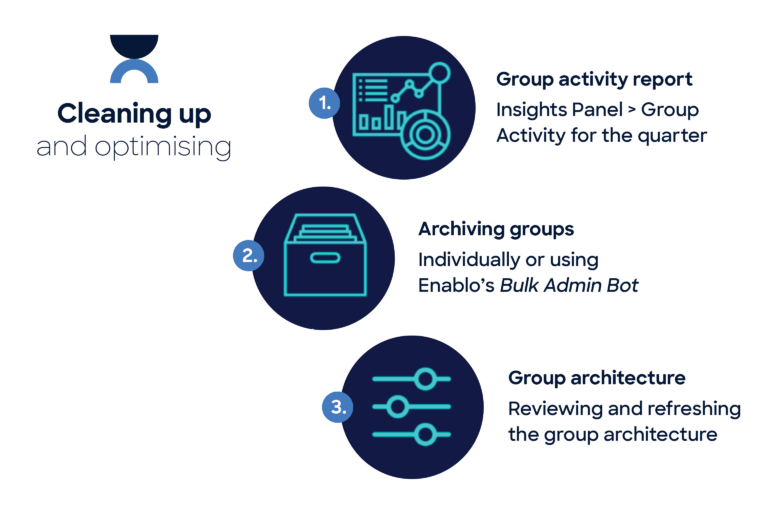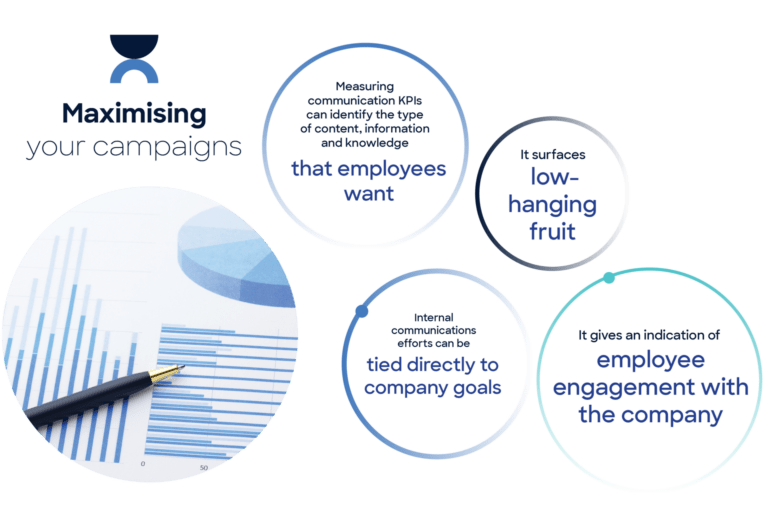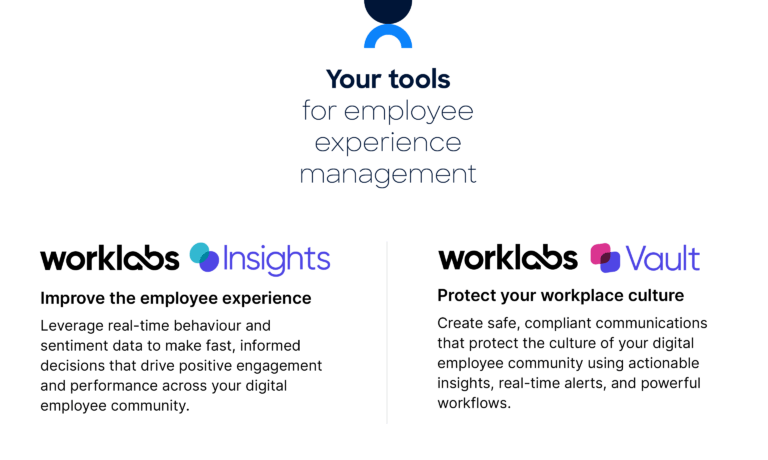Driving Workplace engagement: how to clean up, optimise and measure success on Workplace from Meta
Prioritising strategic communication and authentic engagement is essential for building positive internal relationships within your organisation. When it comes to Workplace, both as a tool and a physical workspace, addressing these physical and digital challenges is vital for a thriving employee experience. Workplace can be a catalyst for real change. But like any platform, to perform at its best, it requires maintenance and attention; otherwise it will just as quickly become a catalyst for an unhealthy work environment. To ensure your Workplace continues to function successfully, there are three things you should do regularly:
- Make sure you have a healthy operating Workplace environment
- Ensure you are strategic about your campaigns
- Report and track Workplace engagement regularly
But before we dive into how we can optimise your Workplace to operate more successfully, we need first to understand why Workplace engagement is so important.
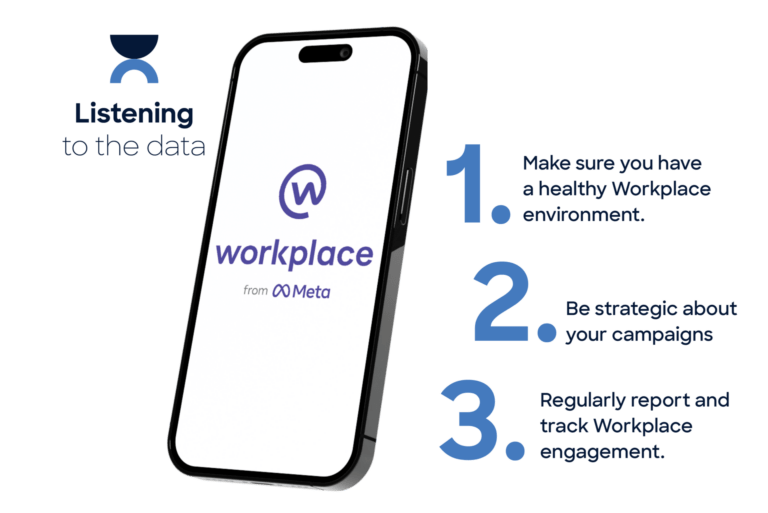
Engagement versus communication. What is the difference?
Employee engagement is the beating heart of a successful workforce, impacting every business area from well-being and culture to productivity and performance. Engagement and communication are often interchangeable, but they are in fact different. While communication focuses on what to say and who to say it to, engagement goes a step further. It isn’t just about what you say and to whom, but about actively seeking feedback and listening. Workplace is a powerful tool that goes beyond traditional communication methods and enhances employee engagement through richer cultural exchanges, recognition, and meaningful relationships. These advantages can extend across the entire employee journey. There are five key drivers of employee engagement on Workplace:
- Work/Job Role: Workplace clarifies expectations, provides updates, and shows how an individual’s role fits into the larger organisation.
- Work Environment: Workplace not only offers the opportunity for remote or hybrid work but also connects a dispersed workforce.
- Rewards and Recognition: A simple post and tag on Workplace can make an employee’s day and contribute to a culture of appreciation.
- Learning and Training Opportunities/Performance Management: Workplace informs employees about available learning resources and allows them to engage in learning activities within the platform.
- Leadership: Workplace facilitates connections between employees and leaders, creating an opportunity for understanding, communication, and feedback.
Because there are so many ways you can drive employee engagement on Workplace, it also means it can be easily overused, underused, or not understood. Your engagement strategy will quickly become outdated if you aren’t actively training leaders and changing and tweaking how you operate on Workplace.
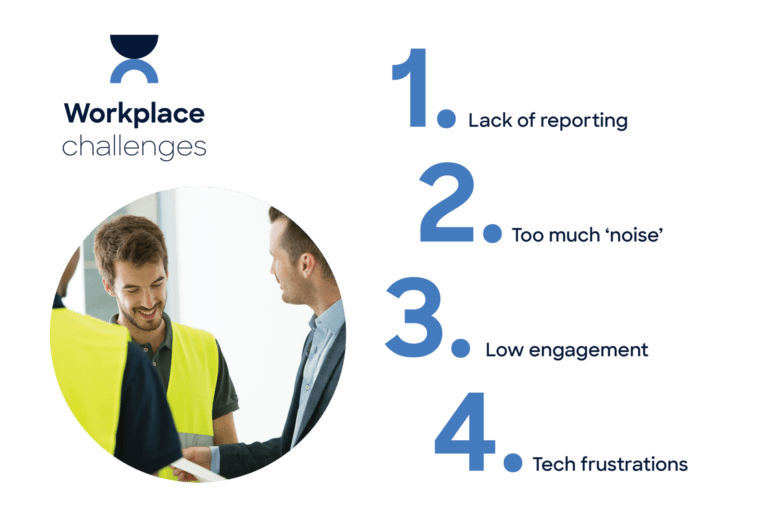
How to optimise your Workplace environment
Without regular maintenance and attention, your Workplace can quickly become a catalyst for disorganisation, just like any neglected tool. Common signs that your Workplace needs some love and attention include:
- Users find it too noisy
- Users struggle to find relevant information
- Low user engagement
- Duplicate or unclear grouping systems
- Lack of user knowledge on how to use the system
Organisations must ensure their Workplace from Meta community operates the best it can to get your communication and engagement initiatives to work. This means Workplace administrators/owners must regularly clean up and optimise their Workplace environment, maximise their campaigns the best they can, and report regularly. Identifying when you need to do this is a skill, but it is crucial to the ongoing success of your community. It’s like having a CRM and never bothering to update or educate others to use it; it creates a bottleneck and reduces productivity. If users find Workplace too noisy or are struggling to find relevant information, this is a telltale sign that your business has some cleaning up to do. Here are some steps for you to consider when looking for Workplace optimisation:
- Review Group Activity: Identify groups with no activity in the past three months and consider archiving them.
- Optimise Group Architecture: Build a comprehensive group structure that includes open default groups, closed location/role/business unit groups, open opt-in groups, and closed location/role/business unit groups.
- Educate Employees: Ensure employees know how to use their Workplace profiles to access relevant information in their News Feed.
- Prioritise Key Groups: Encourage employees to prioritise key groups, follow important individuals, and manage their newsfeeds.
- Promote Posts: Ensure key influencers and leaders are marked to promote posts in the Workplace News Feed.
Maximise your Workplace campaigns
Engaging employees means more than just maintaining a steady stream of internal communications. It’s important to measure engagement, track employee sentiment and optimise messaging based on your findings. Once you have a healthy Workplace infrastructure, focusing on campaigns is essential to gain insights into how your communications resonate with your audience. Campaigns on Workplace make this easy by allowing you to quickly track the performance of multiple posts, allowing you to spend less time gathering data on individual posts and more time gaining insights to improve how you communicate with your people. By dissecting passive and active engagement, along with passive and active reach, you can assess the efficacy of your campaigns more accurately. You can set up a campaign on Workplace quickly and easily using the following steps:
- Go to Campaigns from the Admin Panel and click on + Create Campaign. Give your campaign a name and click Create.
- Add posts to your campaign.
- Analyse how people engage with your campaign via two reporting options: People and Engagement. You’ll also be able to see the average percentage of the campaign that was read, as well as the overall campaign sentiment. Campaign sentiment is based on the overall proportion of negative, neutral and positive comments.
- Explore stats on individual posts and analyse engagement across Workplace as a whole. Explore stats on job title, department, location, and more to understand which segment of your organisation your campaign resonates with the most.
- Track engagement and campaign sentiment over time and tweak your strategy accordingly to maximise your results for future campaigns.
Tracking internal communications campaigns on Workplace is crucial for several reasons:
- Indicative of Employee Engagement: It serves as an indicator of employee engagement with the company.
- Alignment with Company Goals: Effective communication and engagement contribute to attaining the company’s objectives.
- Understanding Employee Preferences: Measurement helps identify the types of content that resonate most with employees.
- Efficiency Enhancement: Focusing on channels that pique employee interest enhances overall efficiency.
Report regularly
Success in Workplace engagement requires ongoing efforts. Regular reporting can help identify problems early, opportunities for improvement, and trends. It also lets you set benchmarks aligned with your goals and objectives, enabling you to take action when needed.
- With regular reporting, you can:
- Solve problems before they worsen
- Find opportunities for improvement
- Take action when it matters
- Share insights within the business
- Look for trends
- Keep the positive flow going
- Set benchmarks to align with goals and objectives
The one downside to the Workplace Insights panel is there is still a fair bit of manual work to manipulate your data and some key metrics are missing. It is possible to achieve great insights through manual reports, but time is most often what communication professionals do not have on their side. This is where an analytics tool like Worklabs can help you manage your ongoing reporting. Worklabs is an employee intelligence platform that enables you to measure the employee experience on Workplace by leveraging real-time behaviour and sentiment data to make fast, informed decisions that drive positive engagement and performance across your digital employee community. The power of Worklabs is its ability to provide data on the pain points experienced within your organisation and give the information needed to create the right strategies to solve them. It also allows you to analyse different divisions within your organisation with powerful segmentation, where you could look at the interaction rate of a specific team. Worklabs lets you drill down to a group and understand how they engage on Workplace and enables you to build reports straight from the multiple metrics available. Key benefits of Worklabs include:
- Identifying thriving teams and leaders for knowledge dissemination
- Real-time engagement assessment across diverse segments of the organisation
- The capacity to effect profound, enduring change by focusing efforts where they matter most
- Continuous tracking of trends and fluctuations over time.
Conclusion
Workplace from Meta has proven to be a catalyst for enhancing employee engagement through richer cultural exchanges, recognition, and meaningful relationships, benefiting all divisions and departments. But driving workplace engagement is a multifaceted mission that demands a strategic approach, ongoing dedication, and the right tools.
By auditing your Workplace platforms health regularly, you can optimise your environment to address issues like noise, information overload, and group clarity more quickly. Once you have have the optimal environment, you can then start to understand your employee and organisational objectives better by utilising the campaigns feature more strategically. By reporting regularly, you can also identify essential problems and uncover opportunities for improvement while tracking trends across your digital employee community. And to help your leaders make better strategic decisions, consider using analytics tools like Worklabs to help you elevate employee engagement, improve productivity, innovation, and increase retention rates.
Make sure you treat your Workplace community like any other enterprise communication tool. Remember, your employees need and company objectives will continue to change and evolve, and therefore, so too should your Workplace strategy.
If you need help optimising your Workplace engagement or are looking for tools with richer insights that will better support your business strategy such as Worklabs, get in touch with one of our employee experience experts by clicking the ‘Book a Chat’ button below, today.

